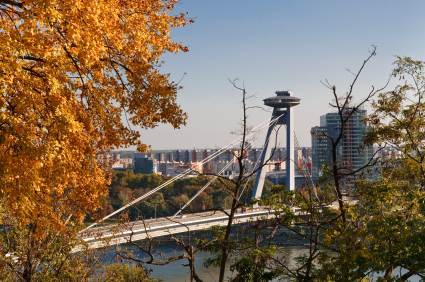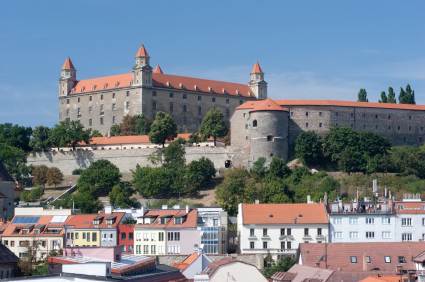|
|
March 21, 2011
Slovakia, Part 2

The
Novy Most (New Bridge) was built by the Communists in 1972 when I was
in college and events in this part of the world were an outright
mystery. It too has a distinctive show-off design, this time like an
alien envisioned by HG Wells. A huge silver saucer with windows perched
on giant stilts above the bridge extends cables to the bridge's middle.
From one angle it looks like the figure is dominating and possessing
the bridge; from another it is shooting death rays.
To make room for the bridge's entry into Bratislava
proper, the Communists took out most of the Jewish quarter near my
hotel. Next door there are a few remnants including a tiny
Jewish-Life-in-Slovakia museum and the Chez-David Pension plus a Kosher
Restaurant across the street. I pop into the museum for a few minutes.
Small but rich with artifacts and basic definitions of Jewish customs.
The Communists didn't have to clear the ghetto of its inhabitants to
make the bridge-road because they all left before 1950. Now there are
only 4000 Jews in the whole country, "mostly living in cities," the
curator says, implying that life would be impossible for them in small,
rural villages.
The gene pool is here exceptionally mixed. Estonians
seem to know they are Estonian, especially as distinct from Russians,
and the Soviets rounded up the Poles from other Soviet bloc countries
and returned them to Poland, so Poland is unmistakably filled with
Poles. Slovakia, however, is in a region with borders that have shifted
like the tides down through the centuries. The Czech Republic,
Slovakia, Austria, Hungary all bump against each other. An art museum
director calls the area “the Far Closeness.”
I found a Mexican restaurant last night with great
food that is only vaguely Mexican. Paprika replaces chili peppers in
this part of the world so the effect is odd but tasty. I noticed all
the waitresses are wearing black t-shirts with the same logo: a red
circle with a line through it showing a hand groping a large breasted
woman. Underneath a caption says “Only for Boss.” I feel a jab of pity
and remember a cab driver in Romania who had a similar sign on his
dashboard. When I asked why, he said that drunken male passengers often
groped their female companions in his cab. Despite the restaurant boss’
loutish joke the warning on the t-shirt was about something real.
When I ask my one local contact to give me three
words that describe “Slovakian” she thinks hard before replying
“outgoing, nature lovers, underpaid.”
She says she has arguments with her Hungarian
friends about whether Atilla the Hun rightfully claimed the area or
whether he stole it. The Hungarians claim he traded it for a white
horse but the Slovaks in the group will argue that there were no white
horses in Asia during Atilla’s time.
As in all of Eastern Europe, the people here butt in
line or threaten to. I speculate that it is a hang-over from the
Communist days when life was harder, supplies were skimpy and you
couldn’t trust strangers. They have tunnel vision until they get their
place in line; then they wait. I notice at a tram waylay that the older
people, the ones who would have lived under Communist rule, wait with a
contained, passive stillness. The younger ones are more mobile, twitchy
with life or half-dancing to iPods.
The police seem friendly or at least don’t stand out
unlike, say, in Prague where they have a spooky, paramilitary cast.
Here they seem matched to the relaxed context. In the tourist quarter,
they act service-oriented and courtly.
Culturally, Bratislava doesn't exactly seem to know
what it is right now. Or rather it is conscious of what it has lost on
the way to becoming something new. There are references to an
inferiority complex it may have compared to the much larger Vienna. As if
to reassure, a Viennese magazine calls the city "Vienna's confident
little sister." Referring to the Communists a local publisher says,
"The old Bratislava almost disappeared from the map. Our cultural
heritage has suffered enormous damage. Put simply, two or three
post-war generations wrecked almost everything that has been built over
the centuries."
As a visitor I realize I've made a mistake
concentrating solely on the capital. The rest of the country looks
fascinating.

|
|
|
|
Products
* About
* Enneagram
* Ericksonian
Hypnosis
Join Our
Mailing List
|
|
We
will notify you of new blog posts, upcoming product specials
as well as
new podcasts, workshops, CDs,
videos and books.
|
|
|